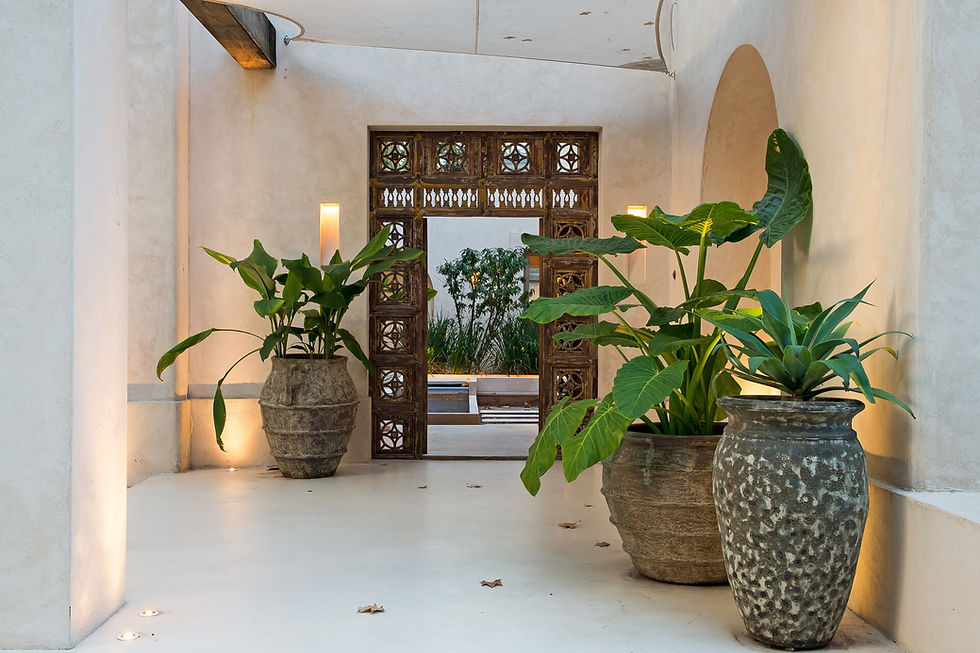How Light Temperature Transforms Colours in Your Space in Dubai
- Jacob Cohen

- Nov 26, 2024
- 4 min read
When designing a home or commercial space, selecting the perfect finish is a critical step. Whether it’s microcement, paint, or textured paint, the true beauty of your chosen colour can change dramatically depending on one key factor: lighting.
At Dusk & Dune, we know that understanding how light temperature affects colour is essential for achieving flawless results. This is especially true for finishes like microcement, where subtle shifts in lighting can completely alter its tone and texture. In this blog, we’ll explore why light temperature matters, how it impacts colour perception, and how to ensure your finishes look stunning—day and night.
Light Temperature: The Key to Colour Perception
Light temperature is measured in Kelvin (K) and refers to the hue of light emitted by a bulb. Different light temperatures influence how colours are perceived, meaning the same shade can look entirely different under warm, neutral, or cool lighting. Here’s how it works:
Warm Light (2,700K - 3,000K):
Adds richness to earthy tones like browns, reds, and oranges.
Can soften cooler shades, making blues and greys appear muted.
Neutral Light (4,000K - 4,500K):
Mimics natural daylight, providing a balanced and true-to-life appearance.
Works well for testing colours in their most authentic state.
Cool Light (5,000K - 6,500K):
Enhances whites, greys, and blues, giving them a modern and crisp edge.
May make warm colours like yellows and reds appear harsher.
These effects apply not just to paint but to microcement and textured paint finishes as well. Each reacts uniquely to light, meaning careful consideration is needed to achieve your desired aesthetic.
Why Microcement Is Particularly Sensitive to Light
Microcement is a highly versatile finish, prized for its seamless texture and ability to adapt to any design style. However, its minimalist surface makes it especially sensitive to changes in light temperature:
A neutral grey microcement might look warmer and more inviting under natural daylight but take on a cooler, more industrial tone under artificial lighting.
Subtle colour undertones can become more or less pronounced, depending on the time of day or the light source.
Textures in microcement, which are often barely noticeable in warm light, can appear more dramatic and defined under cool lighting.
This sensitivity makes it essential to test microcement in the actual lighting conditions of your space before finalising your choice.
It’s Not Just Microcement: Paint and Textured Paint Are Affected Too
While microcement is the focus of our upcoming demonstration, it’s worth noting that paint and textured paint are equally affected by light temperature. For instance:
Flat paint finishes may appear even and consistent in daylight but lose vibrancy under cooler artificial light.
Textured paint finishes with metallic or reflective properties can take on entirely new characteristics depending on the light source.
A rich, dark colour might look cosy in warm lighting but stark or overwhelming in cool lighting.
Whether you’re using decorative paint or microcement, understanding how light interacts with these finishes is key to creating a space that feels harmonious and intentional.
The Dubai Factor: Time of Day Changes Everything
In Dubai, natural lighting plays a significant role during the day, with the desert sun flooding interiors with a warm, golden glow. However, this changes dramatically in the evening when artificial lighting—often cooler in tone—dominates.
This means that the colours you choose may look completely different depending on the time of day:
During daylight hours, warm natural light may enhance earthier tones in microcement or paint, making them feel cosy and inviting.
In the evening, artificial light can bring out cooler tones, giving the same finishes a sleek and modern feel.
For spaces that are primarily used in the evening—like living rooms, dining rooms, or commercial spaces in Dubai—it’s critical to evaluate how finishes will look under artificial lighting.
Tips for Choosing Finishes with Light Temperature in Mind
Getting the colour right is more than just picking a shade. Here are our top tips for making informed decisions:
Test Your Finishes:
Use sample boards or swatches to see how microcement, paint, or textured paint perform under different light temperatures.
Observe these finishes at various times of the day to understand how natural and artificial light affect their appearance.
Prioritise Lighting Design:
Incorporate layered lighting, including ambient, task, and accent lights, to create a flexible environment where colours and textures can shine in every setting.
Match Lighting to Function:
For relaxing spaces, such as bedrooms and lounges, warm lighting enhances comfort and tranquillity.
For functional spaces, like kitchens or offices, neutral or cool lighting provides clarity and focus.
Work with Experts:
Consult with professionals, like the team at Dusk & Dune, who understand the interplay between light, texture, and colour.
How Dusk & Dune Can Help
At Dusk & Dune, we specialise in luxurious microcement finishes and high-quality paint products, designed to transform your space. We take pride in sourcing the finest materials, including 100% European products, to ensure exceptional results.
To help you navigate the complexities of light temperature, we’re introducing our Light Temperature Wand Demonstration. This innovative tool will show you how light impacts microcement finishes and other materials, allowing you to make informed decisions for your project.
See It in Action
Curious about how light temperature can transform your finishes? Keep an eye on our Instagram for a special reel, where we’ll use our Light Wand to demonstrate how microcement looks under warm, neutral, and cool lighting. The results will surprise you!
Ready to create a space that looks flawless in every light? Contact Dusk & Dune today for expert advice and premium finishes that adapt beautifully to their environment.








Comments